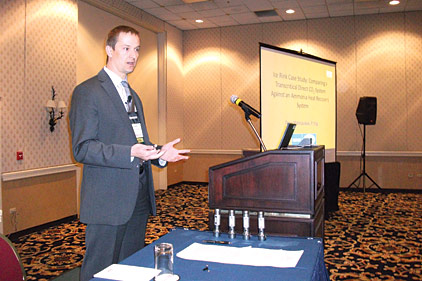
|
| Dave Malinauskas of Cimco Refrigeration, Toronto, served as one of the presenters during the IIAR conference. His topic was transcritical CO2 in ice rinks. |
COLORADO SPRINGS, Colo. — Making ammonia work in traditional HFC territory, trying transcritical CO2 systems in ice rinks, and examining ways to apply refrigeration principles to heat transfer rates were just three topics of 13 papers (five in Spanish) presented at the most recent Industrial Refrigeration Conference and Expo, presented by the International Institute of Ammonia Refrigeration (IIAR) in Colorado Springs.
The timelines and diversity of the papers were a reflection of the IIAR response to ongoing developments regarding wider use of natural refrigerants as well as a continued commitment to the basics of refrigeration.
Territorial Crossing
The paper titled, “Ammonia in Traditional HFC Territory: How Does It Compare?” was presented by Stefan S. Jensen, an engineer with Scantec Refrigeration Technologies in Brisbane, Queensland, Australia.
His basic premise related to what’s happening in his home country regarding a carbon tax bill approved by the Australian Senate including a special levy on HFC refrigerants. “This has increased the retail price of HFCs by 300-500 percent,” he said. “There are several pathways available to Australian refrigeration and air conditioning plant users of avoiding the impact of the levy on HFC refrigerants. It has been a common misconception that these pathways are generally characterized by a capital cost penalty and lack of acceptable benefit(s) in terms of return on additional investment. By way of practical, real-life comparisons, this paper details the end-user business benefits associated with giving ammonia a chance in those medium-size applications, which prior to the advent of the carbon tax bill were reserved for HFC refrigerants.”
His study looked at four dual-stage ammonia refrigeration systems in different parts of Australia with a range of ambient temperatures.
“The plant designs are characterized by the application of a range of relatively innovative design concepts including automatic ambient air defrost in frozen-storage facilities, automatic oil return and oil distribution to the compressors, office air conditioning by means of ammonia refrigerant, variable-speed drive semi-industrial and industrial reciprocating compressors, employment of secondary refrigerant in chilled storage rooms, automatic venting of ammonia vapors from frozen storage rooms in the event of leaks, floating evaporating and condensing pressures, and so on.”
The 32-page report went on to detail the findings showing varying results but pointing toward ammonia as a viable option especially due to rising HFC costs.
“Ammonia solutions have the capacity to address both the issue of fugitive emissions (refrigerant leaks) from refrigeration systems and
indirect emissions that are a result
of the consumption of electrical energy by refrigeration systems,” said Jensen. “Ammonia is not subject to any environmental levies. Ammonia has superior vapor compression cycle efficiency to synthetic refrigerants. Ammonia is therefore part of the solution to the problems faced by many legislators in many jurisdictions.”
On Ice
Dave Malinauskas, of Cimco Refrigeration, Toronto, presented a paper examining the use of transcritical CO2 at an ice rink instead of an ammonia heat-recovery system.
“Refrigeration systems with heat-reclaim capabilities appear to be the perfect solution for large community centers whereby utilizing the waste heat from the refrigeration system as a source of building heat will reduce both the carbon footprint and the operating cost to owners. However, to properly determine the impact of a heat-recovery refrigeration system in an ice rink, a study must be done which analyzes the heating requirements of the building, and then compares this against the heat available from the refrigeration system. Then, based on the cost of energy, a further analysis can be done to determine if an investment in energy-efficient heat-recovery refrigeration system equipment is a good investment.”
At the same time, “The re-emergence of carbon dioxide as a refrigerant provides another alternative for ice rink refrigeration systems. This is a natural extension of transcritical supermarkets which are gaining popularity in Europe,” said Malinauskas. “When operated transcritically, carbon dioxide can take advantage of the waste heat in the refrigeration process as it has very high discharge temperatures. This heat can offset the energy required for building heating applications.”
Heat Transfer
“Heat Transfer Rates and Refrigeration System Performance” was the topic for Tim Clapp, an engineer with Leo A. Daly, an Omaha, Neb.-based architecture and engineering firm.
“Heat transfer rates are a fundamental factor in determining the performance of the refrigeration system,” he said. “Applying basic refrigeration principles to heat transfer rates, we can accurately predict the effect on the remaining elements, system efficiency, and the refrigeration components.”
He said his paper “provides a simple method, using tables and graphs, to assist in selecting set points and equipment with the ideal heat transfer rates for enhancing the performance of a system.
“The topics of frost and flow regime are introduced, as they relate to the heat transfer characteristics of any fluid.”
One aspect of his findings was that “part-load conditions, and careful consideration of the overall system operation, are going to have a significant impact on the overall coefficient of performance, and deciding which heat exchangers are the best selections. There is no magic answer for solving all of your heat exchanger needs; there is only thorough analysis, and utilizing the tools at hand.”
Publication date: 7/15/2013
Want more HVAC industry news and information? Join The NEWS on Facebook, Twitter, and LinkedIn today!






